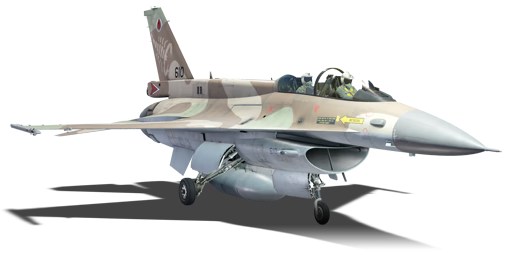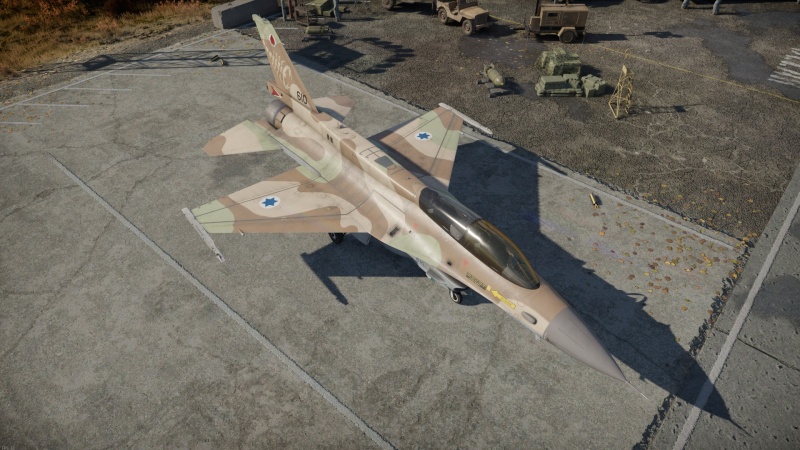Barak II
Contents
Description
The F-16D Block 40 Barak II is a rank VIII Israeli jet fighter with a battle rating of 12.3 (AB) and 12.7 (RB/SB). It was introduced in Update "Sons of Attila".
General info
Flight performance
Describe how the aircraft behaves in the air. Speed, manoeuvrability, acceleration and allowable loads - these are the most important characteristics of the vehicle.
| Characteristics | Max speed (km/h at _,___ m) |
Max altitude (metres) |
Turn time (seconds) |
Rate of climb (metres/second) |
Take-off run (metres) | |||
|---|---|---|---|---|---|---|---|---|
| AB | RB | AB | RB | AB | RB | |||
| Stock | ___ | ___ | 15240 | __._ | __._ | __._ | __._ | ___ |
| Upgraded | ___ | ___ | __._ | __._ | __._ | __._ | ||
Details
| Features | |||||
|---|---|---|---|---|---|
| Combat flaps | Take-off flaps | Landing flaps | Air brakes | Arrestor gear | Drogue chute |
| _ | _ | _ | _ | _ | _ |
| Limits | ||||||
|---|---|---|---|---|---|---|
| Wings (km/h) | Gear (km/h) | Flaps (km/h) | Max Static G | |||
| Combat | Take-off | Landing | + | - | ||
| 0 | 482 | ___ | ___ | ___ | ~__ | ~__ |
| Optimal velocities (km/h) | |||
|---|---|---|---|
| Ailerons | Rudder | Elevators | Radiator |
| < ___ | < ___ | < ___ | - |
Engine performance
| Engine | Aircraft mass | |||||
|---|---|---|---|---|---|---|
| Engine name | Number | Basic mass | Wing loading (full fuel) | |||
| _____ | _ | _,___ kg | ___ kg/m2 | |||
| Engine characteristics | Mass with fuel (no weapons load) | Max Gross Weight | ||||
| Weight (each) | Type | _m fuel | __m fuel | __m fuel | ||
| ___ kg | ___ | _,___ kg | _,___ kg | _,___ kg | _,___ kg | |
| Maximum engine thrust @ 0 m (RB/SB) | Thrust to weight ratio @ 0 m (___%/WEP) | |||||
| Condition | 100% | ___%/WEP | _m fuel | __m fuel | __m fuel | MGW |
| Stationary | ___ kgf | ___ kgf | _.__ | _.__ | _.__ | _.__ |
| Optimal | ___ kgf (_ km/h) |
___ kgf (_ km/h) |
_.__ | _.__ | _.__ | _.__ |
Survivability and armour
Examine the survivability of the aircraft. Note how vulnerable the structure is and how secure the pilot is, whether the fuel tanks are armoured, etc. Describe the armour, if there is any, and also mention the vulnerability of other critical aircraft systems.
Modifications and economy
Armaments
Offensive armament
The Barak II is armed with:
- 1 x 20 mm M61A1 cannon, wing root-mounted (512 rpg)
- 200 x countermeasures
Suspended armament
Describe the aircraft's suspended armament: additional cannons under the wings, bombs, rockets and torpedoes. This section is especially important for bombers and attackers. If there is no suspended weaponry remove this subsection.
Usage in battles
Describe the tactics of playing in the aircraft, the features of using aircraft in a team and advice on tactics. Refrain from creating a "guide" - do not impose a single point of view, but instead, give the reader food for thought. Examine the most dangerous enemies and give recommendations on fighting them. If necessary, note the specifics of the game in different modes (AB, RB, SB).
Pros and cons
Summarise and briefly evaluate the vehicle in terms of its characteristics and combat effectiveness. Mark its pros and cons in the bulleted list. Try not to use more than 6 points for each of the characteristics. Avoid using categorical definitions such as "bad", "good" and the like - use substitutions with softer forms such as "inadequate" and "effective".
Pros:
Cons:
History
In the late 70s, Israel began its ambitious project to produce its first locally-manufactured jet fighter, meant to replace the aging IAI Kfir. Learning from their previous work on the Mirage and Kfir programs, and borrowing ideas from America's then-new F-16A fighter jet (which had entered IAF service in 1980 as the "Netz"), Israeli aeronautic engineers were able to develop a highly-maneuverable, delta-wing, single-seat fighter of their own - the IAI Lavi.
After nearly a decade of development the Lavi's first prototype was flown in 1986, and reportedly proved extremely capable. The United States, which had up to that point supported and partially funded the Lavi project, was dismayed to learn that the new aircraft might be good enough to provide a much cheaper competitor for the F-16 on the export market. The Reagan administration soon began pressuring the Israeli government to cancel the project. Though Israel's defense minister Moshe Arens was strongly behind the Lavi, the project's ever-increasing pricetag made it easy for the rest of the Israeli government to agree to US demands. The Lavi project was finally canceled in late 1987.
In compensation for torpedoing Israel's fighter manufacture ambitions, the United States agreed to sell Israel additional F-16Cs and Ds. A significant number of them, all from the Block 30 model, had already been sold to Israel by that point, entering IAF service under the codename "Barak" (Lightning) in late 1987. In 1988, the US and Israel signed that new "compensation" deal - named "Peace Marble III" - delivering a total of 60 F-16s, all from Block 40, between 1991 and 1993. Half were F-16Cs and half were F-16Ds (single-seat and double-seat, respectively). In the IAF, these new Block 40 aircraft were named "Barak II" (Lightning II), correspondingly amending the name of the older Block 30 aircraft to "Barak I" (note: the IAF does not keep separate names for single- and double-seat variants of the F-16).
The F-16C/D has several advantages over the F-16A/B, but the most important is the ability to mount a LANTIRN pod, turning the plane into an all-weather operator. As Israeli engineers had done with all other combat planes purchased for the IAF in the last 50 years, they've also updated most of the avionics and introduced many locally-manufactured, cutting-edge improvements. This included completely redone Multi-Function Displays (MFDs) and in-helmet Heads-Up Display (HUD), among multiple other changes.
Barak II aircraft have taken part in almost every Israeli military campaign since their introduction, including the Second Lebanon War of 2006. Nevertheless, the changing needs of the Israeli Air Force have created a demand for a more dedicated fighter in the long-distance and precision-strike roles, resulting in the birth of the F-16I "Sufa". This heavily-modified F-16D Block 52 has since completely replaced the Barak in those roles, leaving it only with mid-altitude interception duties, which it still performs to this day. However, with the F-35 "Adir" now increasingly filling that role, there are ever-growing calls within the Israeli military community to finally retire the Barak II.
Media
Excellent additions to the article would be video guides, screenshots from the game, and photos.
See also
Links to the articles on the War Thunder Wiki that you think will be useful for the reader, for example:
- reference to the series of the aircraft;
- links to approximate analogues of other nations and research trees.
External links
Paste links to sources and external resources, such as:
- topic on the official game forum;
- other literature.
| Israel jet aircraft | |
|---|---|
| Kfir Canard · Kfir C.2 · Kfir C.7 · Nesher | |
| Britain | |
| Meteor | Meteor NF.13 · Meteor F.8 |
| France | |
| Vautour | Vautour IIA · Vautour IIN |
| Super Mystere | Sambad · Sa'ar |
| Mirage III | Shahak |
| Other | M.D.450B Ouragan · Mystere IVA |
| USA | |
| F-84 | F-84F |
| A-4 | A-4H · A-4E Early (M) · A-4E · Ayit |
| F-4 | Kurnass · Kurnass 2000 |
| F-15 | Baz |
| F-16 | Netz · Barak II |





